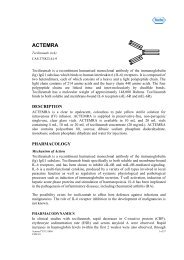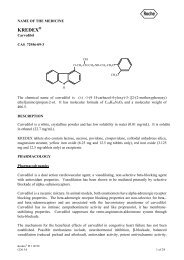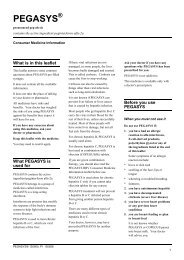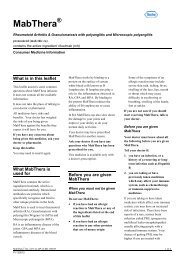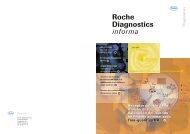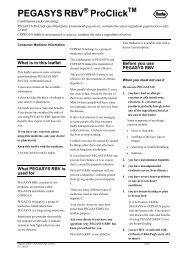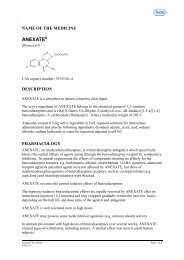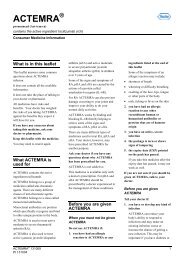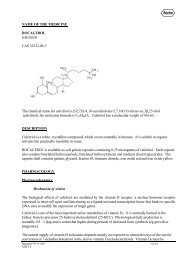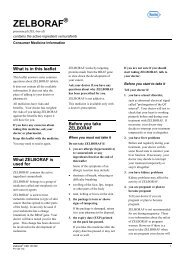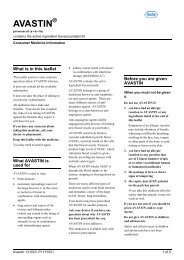Konakion MM Paediatric - Product Information (PI) - Roche Australia
Konakion MM Paediatric - Product Information (PI) - Roche Australia
Konakion MM Paediatric - Product Information (PI) - Roche Australia
Create successful ePaper yourself
Turn your PDF publications into a flip-book with our unique Google optimized e-Paper software.
DOSAGE AND ADMINISTRATION<br />
r<br />
<strong>Konakion</strong> <strong>MM</strong> <strong>Paediatric</strong> may be given by intramuscular, oral or intravenous routes. Care should be taken<br />
to ensure the correct dose is given for the chosen route of administration.<br />
Prophylaxis<br />
All healthy neonates<br />
1 mg (0.1 mL) IM at birth is recommended.<br />
Alternatively, 2 mg (0.2 mL) orally at birth, at the time of newborn screening (3-5 days of age) and at 4<br />
weeks.<br />
For predominately formula fed neonates the last oral dose may be omitted.<br />
Neonates with special risk factors<br />
1 mg IM at birth is recommended in neonates with special risk factors. If the neonate has special risk<br />
factors and weighs less than 1.5 kg, then 0.5 mg (0.05 mL) is recommended (see PRECAUTIONS).<br />
The size and frequency of further doses should be based on clinical grounds and coagulation status.<br />
Clotting and <strong>PI</strong>VKA-II (Proteins Induced in Vitamin K Absence) tests are not to be relied upon as<br />
indications of deficiency as the relationship between biochemical evidence of deficiency and late VKDB is<br />
not clear.<br />
Special Risk Factors<br />
Early and/or classical VKDB<br />
Risk factors include: prematurity, birth asphyxia, delay in establishment of oral feeding, maternal use of<br />
anticoagulants, antiepileptics or tuberculostatics and antibiotic treatment.<br />
Late VKDB<br />
Risk factors include liver dysfunction including obstructive jaundice, malabsorption and prolonged use of<br />
antibiotics.<br />
Therapy<br />
Initially, 1 mg by intravenous injection, with further doses as required, based on the clinical grounds and<br />
coagulation status. In certain circumstances, treatment with <strong>Konakion</strong> <strong>MM</strong> <strong>Paediatric</strong> may need to be<br />
accompanied by more direct forms of effective haemorrhage control, such as transfusion of whole blood or<br />
coagulation factors, to compensate for severe blood loss and the delayed response to vitamin K 1 .<br />
VKDB should be suspected with any minor bleed in infants less than 6 months of age, even if coagulation<br />
tests are within normal limits. Clotting and <strong>PI</strong>VKA-II tests are not to be relied upon as indications of<br />
deficiency as the relationship between biochemical evidence of deficiency and late VKDB is not clear.<br />
Administration<br />
Parenteral use<br />
<strong>Konakion</strong> <strong>MM</strong> <strong>Paediatric</strong> should not be diluted or mixed with other parenteral medications.<br />
Oral use<br />
(with the dispenser included in the package)<br />
- after breaking the ampoule, place the dispenser vertically into the ampoule;<br />
- withdraw the solution from the ampoule into the dispenser until the solution reaches the marking on the<br />
dispenser ( = 2 mg vitamin K 1 );<br />
<strong>Konakion</strong> <strong>MM</strong> <strong>Paediatric</strong> ® <strong>PI</strong> 090703 4 of 5<br />
IS<strong>PI</strong> 2.0



